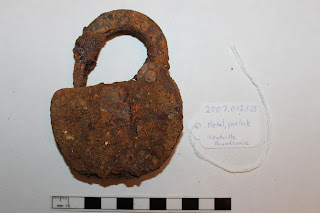Assessment (Continued.....)
 |
| Large locomotive wrench |
 |
| Heavily corroded padlock |
There is a very corroded (rusted) padlock shown on the left that may have a makers mark that could be revealed by removing the loose layers of corrosion. Once again, makers marks can help provide history of the object and date it. The padlock is frozen in the position shown - it does not move when minimal pressure is applied.
There were two glass objects assessed: a clear glass lid for a compote jar and a glass insulator for a power line. It is not clear if the glass lid was imported from elsewhere or made locally. It may be possible to determine this when it is cleaned and compared to some similar objects currently in the museum's locally made glass collection.
Conservation Tip: For all metals I am proposing that I remove all loose rust and apply a fine layer of museum grade wax heated with a hair dryer and applied with a brush. This will stabilize the object to avoid it deteriorating any further. In the top photograph you can see some flecks of corrosion which come off when handled. This would not happen if treated as I propose. The coating of wax would block contact with moist air yet allow the object to be viewed. The wax is easily removed by reheating with a hair dryer and wiped off with a clean cloth. There were two other metal objects assessed at the same time: a brake wheel and three rail spikes. All will require the same treatment. Caution: Most metals expand when heated and contract when cooled so it is important to make sure that the metal objects are stable and can withstand a minor amount of heat such as with a hair dryer.
No comments:
Post a Comment